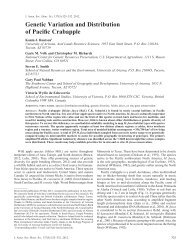CONSERVATION
Conservation You Can Taste - The Southwest Center - University of ...
Conservation You Can Taste - The Southwest Center - University of ...
- No tags were found...
Create successful ePaper yourself
Turn your PDF publications into a flip-book with our unique Google optimized e-Paper software.
This astonishing level of diversity is not simply produced in American gardens, orchards,<br />
farms and ranches, but it is more than ever before reaching consumers and chefs. In 1994,<br />
there were only 1775 farmers markets in the U.S., but two decades later, there are over 8150,<br />
where one in every twenty farmers and ranchers in the country direct-markets at least a<br />
portion of her or his production to neighbors.<br />
Obviously, not many of us will ever have the chance to taste even a fraction of the five<br />
thousand species that can be used as food on this continent, so why do they matter? Here are<br />
just a few of the reasons that they will matter if we are to achieve food security that nourishes<br />
our poor, elderly and children, and that sustains the long-term productivity of our foodscapes.<br />
A. Maintaining a diversity of plants and animals on the land and in our waters may<br />
be one of the best bet-hedging strategies we have to buffer ourselves from climate<br />
uncertainty.<br />
B. Harboring biodiversity on farm allows these plants and animals to provide “ecosystem<br />
services” which stabilize yields and reduce required inputs, over and above the calories they<br />
produce.<br />
C. A neglected “food rule” to guide our healthy eating patterns is that eating a diversity of<br />
varieties of the same foodstuff--- apples or salad greens---provides us with a greater diversity<br />
of nutrients, probiotics, textures and flavors to keep us fully nourished and protected from<br />
disease.<br />
Perhaps the conservation of flavor options and the very pleasure of eating are the leastdiscussed<br />
among all the reasons for attempting to sustain food biodiversity. The following<br />
case studies—highlighted as sidebar features scattered throughout this report—remind us that<br />
when we conserve food diversity, we are not just saving genes, breeds or species, but we are<br />
saving taste, culture and livelihoods. We hope that you will now dive into the details of these<br />
conservation success stories for they are truly examples of conservation you can taste.<br />
15



